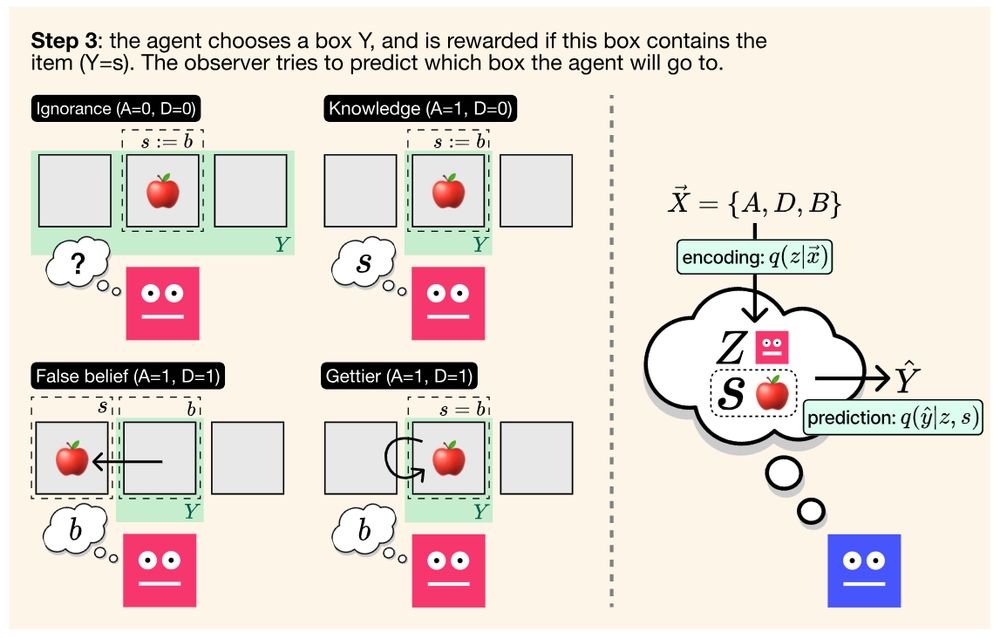Excited that this is now out in @nathumbehav.nature.com 🎉
David Rose (davdrose.github.io) led this project on how children's understanding of causal language develops.
📃 (preprint): osf.io/preprints/ps...
📎: github.com/davdrose/cau...
05.12.2025 16:20 — 👍 46 🔁 11 💬 0 📌 0
Please share widely - we would love a broad range of applicants!
04.12.2025 20:40 — 👍 1 🔁 0 💬 0 📌 0
Apply - Interfolio
{{$ctrl.$state.data.pageTitle}} - Apply - Interfolio
🚨Super excited that Dartmouth's Society of Fellows is hiring a postdoc with the Program in Cognitive Science 🚨 Specialization in computational and empirical approaches to artificial and natural intelligence, including perception, representation, and complex planning: apply.interfolio.com/176946
04.12.2025 20:40 — 👍 30 🔁 26 💬 1 📌 0
Just a quick reminder that applications for our new cross-lab PhD training model in cognitive science at Dartmouth are due Dec. 1. We're quite excited about this new approach, so please reach out if you have any questions!!
25.11.2025 13:28 — 👍 8 🔁 3 💬 0 📌 0
Redirecting
🧠 New paper alert! Can people infer others’ values not from what they choose, but simply from what comes to mind? Across four studies, we show they can—drawing on an intuitive theory of how options are generated.
doi.org/10.1016/j.cognition.2025.106238
👇
05.11.2025 19:31 — 👍 27 🔁 15 💬 1 📌 0

New article w/ M Pabla & @orifriedman.bsky.social
onlinelibrary.wiley.com/doi/10.1111/...
When children claim an unexpected event is impossible they also claim it's never happened, even for immoral events, suggesting their judgments reflect beliefs about what could happen & not merely what should.
24.10.2025 17:00 — 👍 24 🔁 5 💬 1 📌 0
In case you don't know already, the journal Open Mind has a Bluesky account that automatically posts new papers:
@openmindjournal.bsky.social
The journal is diamond open access (free to read, free to publish) thanks to the support of MIT Press, Harvard Library, & MIT Library.
24.10.2025 12:03 — 👍 106 🔁 33 💬 4 📌 2
Cognitive Science Graduate Admissions – Information about graduate admissions from the cognitive science faculty
We're excited to announce that Cognitive Science at Dartmouth is recruiting PhD students to work collaboratively with me, Steven Frankland, and Fred Callaway. Come study the principles and mechanisms that enable us to understand, plan, and act in the world! Info: sites.dartmouth.edu/cogscigrad/
23.10.2025 17:30 — 👍 57 🔁 39 💬 1 📌 1
Homepage of the Action, Computation, & Thinking (ACT) Lab, Yale department of psychology
Happy to announce that my lab @ Yale Psychology (actcompthink.org) will be accepting PhD applications this year (for start in Fall '26)!
Come for the fun experiments on human learning, memory, & skilled behavior, stay for the best 🍕 in the US.
Please reach out if you have any questions!
24.07.2025 13:29 — 👍 111 🔁 51 💬 4 📌 0
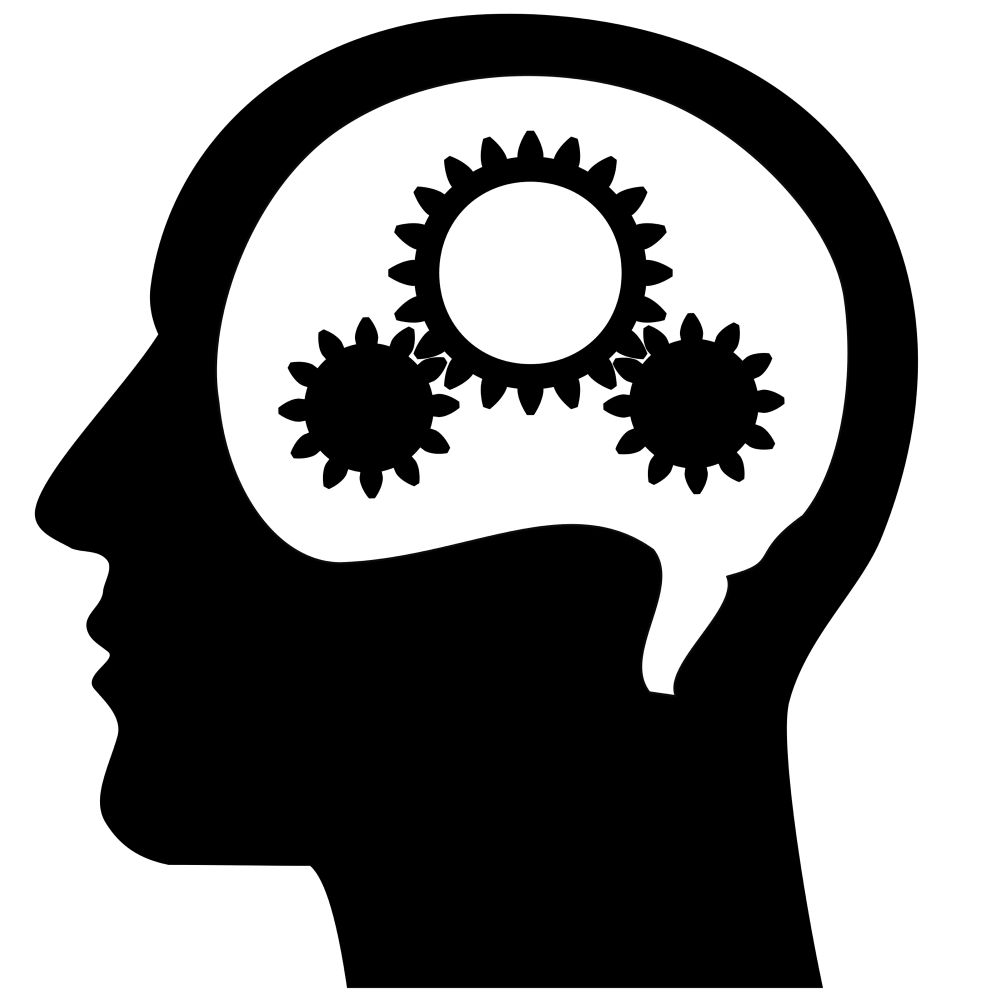
Meta-reasoning @ CogSci
Workshop Description
People are general purpose problem solvers. We obtain food and shelter, manage companies, solve moral dilemmas, spend years toiling away at thorny math problems, and even adopt a...
If you’ll be at #CogSci2025, consider (or at least consider considering) attending our @cogscisociety.bsky.social workshop on meta reasoning
🤔🤨🧐
We’ll be discussing problem selection through various lenses represented by a great lineup of speakers!
24.06.2025 02:01 — 👍 36 🔁 10 💬 1 📌 0
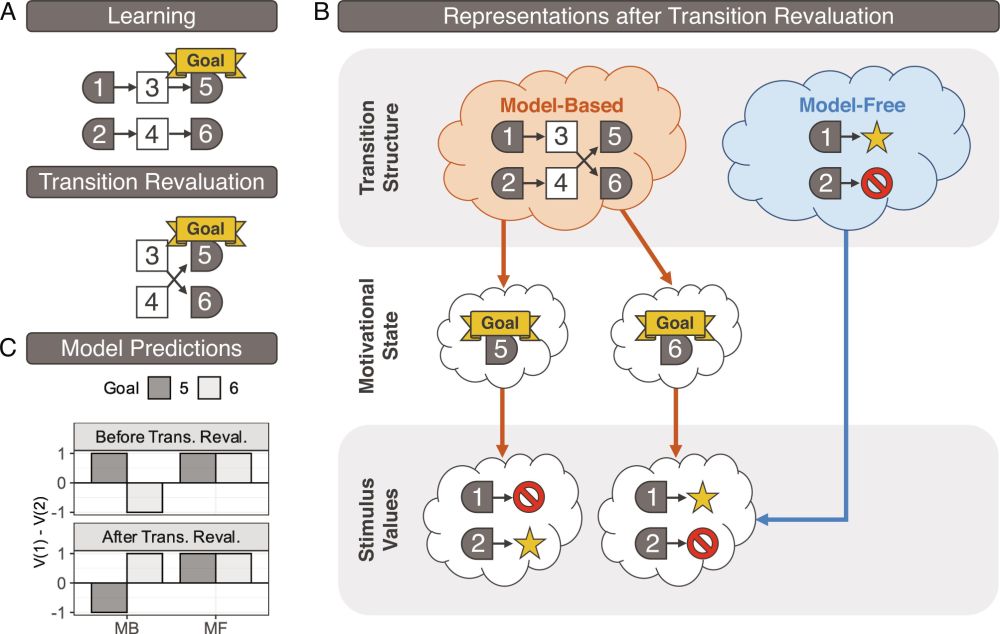
Model-based algorithms shape automatic evaluative processing | PNAS
Computational theories of reinforcement learning suggest that two families of algorithm—model-based
and model-free—tightly map onto the classic dis...
A key takeaway from 20+ years of computational RL is: model-free=automatic, model-based=deliberate. My new paper w/ @benedek.bsky.social challenges this view, suggesting that MB algos are more ubiquitous, & automatic processing more sophisticated, than currently thought: www.pnas.org/doi/10.1073/...
21.06.2025 01:41 — 👍 100 🔁 30 💬 0 📌 2
In the second most important election happening today, I'm on the slate for potential new members of the governing board for the Cognitive Science Society! If you're a member, check your email for a link to vote and #DontRankCuomo
24.06.2025 21:13 — 👍 18 🔁 3 💬 0 📌 0
JOB!
3yr funded post-doc in Theory of Mind inspired by the knowledge first epistemology of Williamson, and the work of @jsphillips.bsky.social. Looking at knowledge and ignorance processing in adults with me and Richard O'Connor at the Uni of Hull. Please re-post.
www.jobs.ac.uk/job/DNE794/p...
22.05.2025 11:03 — 👍 7 🔁 7 💬 0 📌 0
research_data_specialist_Bergelson_ad_2025.pdf
bit of good news: approved technical staff position! link below. please be in touch if this matches your skills & interests! drive.google.com/file/d/16J2J... (hr listing posted harvard-internal now; external soon, per guidelines), happy for ?s & plan on quick turnaround! #CogSciSky #PsychSciSky 🐦🐦
19.05.2025 15:01 — 👍 23 🔁 21 💬 1 📌 0
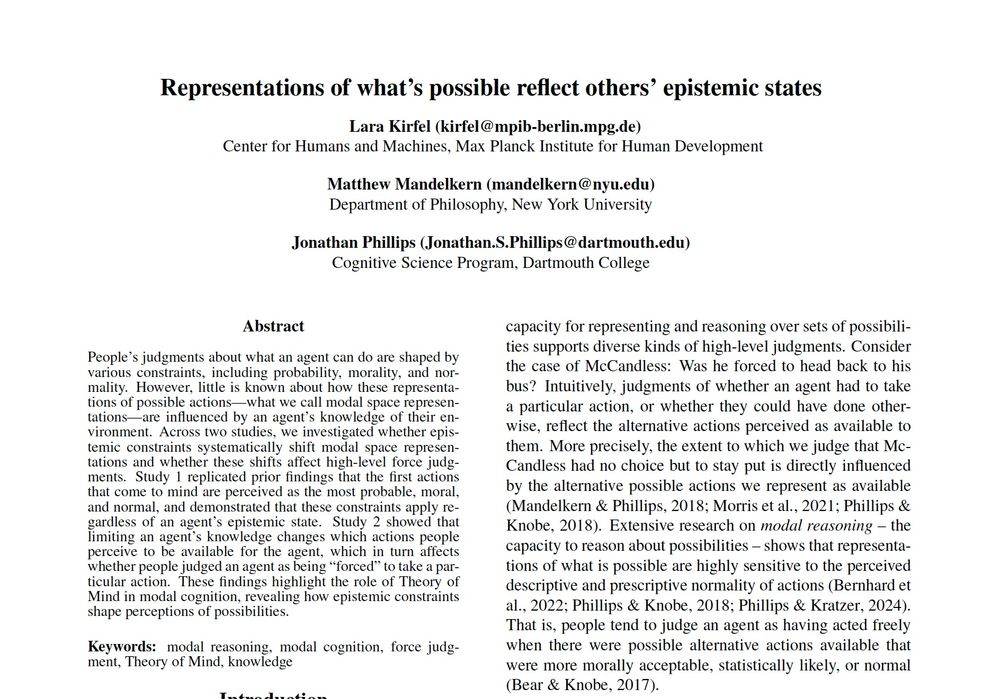
Title: Representations of what’s possible reflect others’ epistemic states
Authors: Lara Kirfel, Matthew Mandelkern, and Jonathan Scott Phillips
Abstract: People’s judgments about what an agent can do are shaped by various constraints, including probability, morality, and normality. However, little is known about how these representations of possible actions—what we call modal space representations—are influenced by an agent’s knowledge of their environment. Across two studies, we investigated whether epistemic constraints systematically shift modal space representations and whether these shifts affect high-level force judgments. Study 1 replicated prior findings that the first actions that come to mind are perceived as the most probable, moral, and normal, and demonstrated that these constraints apply regardless of an agent’s epistemic state. Study 2 showed that limiting an agent’s knowledge changes which actions people perceive to be available for the agent, which in turn affects whether people judged an agent as being “forced” to take a particular action. These findings highlight the role of Theory of Mind in modal cognition, revealing how epistemic constraints shape perceptions of possibilities.
🏔️ Brad is lost in the wilderness—but doesn’t know there’s a town nearby. Was he forced to stay put?
In our #CogSci2025 paper, we show that judgments of what’s possible—and whether someone had to act—depend on what agents know.
📰 osf.io/preprints/ps...
w/ Matt Mandelkern & @jsphillips.bsky.social
16.05.2025 12:04 — 👍 11 🔁 3 💬 0 📌 0
Couldn't be more thrilled that Fred is coming to join us!! Dartmouth Cognitive Science is quickly growing into a group of amazing colleagues that I feel lucky to have around and think with!
12.05.2025 14:57 — 👍 10 🔁 0 💬 0 📌 0
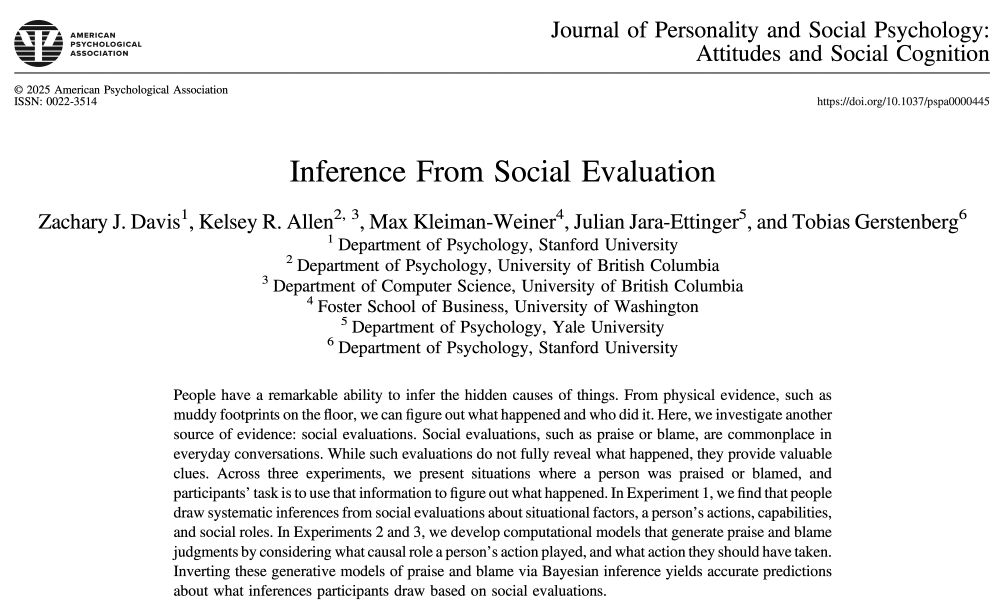
Now out in JPSP ‼️
"Inference from social evaluation" with Zach Davis, Kelsey Allen, @maxkw.bsky.social, and @julianje.bsky.social
📃 (paper): psycnet.apa.org/record/2026-...
📜 (preprint): osf.io/preprints/ps...
25.04.2025 15:55 — 👍 56 🔁 13 💬 2 📌 0

Bonobo Nyota at Ape Initiative, a science and education nonprofit
Are humans the only species that communicates when a collaborator is missing information?
In @pnas.org, Luke Townrow and I show that our closest relatives, bonobos, can track when a partner is knowledgeable or ignorant, and tailor communication accordingly
www.pnas.org/doi/10.1073/...
03.02.2025 22:11 — 👍 204 🔁 63 💬 4 📌 6
OSF
Or this, hopefully now working, OSF link: osf.io/preprints/ps...
24.04.2025 15:44 — 👍 2 🔁 0 💬 0 📌 0
If the OSF link isn't working for you, the preprint can also be found here: dataverse.harvard.edu/file.xhtml?f...
24.04.2025 15:33 — 👍 3 🔁 0 💬 1 📌 0
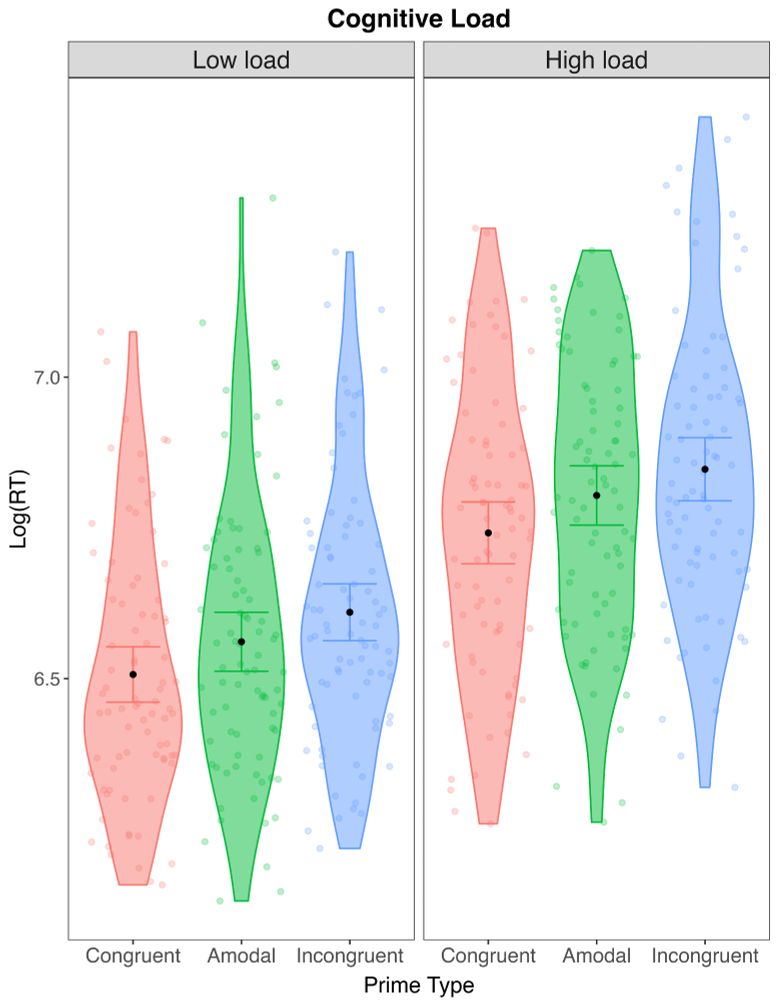

We find that the visual system's representation of multiple possibilities is selectively disrupted by perceptual load, but not cognitive load, demonstrating that the key processes underlying the perception of possibilities occur before the information reaches high-level cognition!
24.04.2025 15:22 — 👍 6 🔁 1 💬 1 📌 0

The key idea (developed with Camden Parker and @violastoermer.bsky.social) was to use amodal completion as a case where the visual system can represent multiple possibilities (possible shapes) and then ask whether this representation is differentially disrupted by perceptual load or cognitive load.
24.04.2025 15:22 — 👍 4 🔁 0 💬 1 📌 0
OSF
In a new paper, we demonstrate the perception of possibilities but show that the processes underlying this phenomenon occur before the information reaches high-level cognition. The representation of these possibilities is distinctly perceptual(!) and separate from cognition. osf.io/preprints/ps...
24.04.2025 15:22 — 👍 31 🔁 8 💬 1 📌 0
Visualizing SEP: An Interactive Visualization and Search Engine for the Stanford Encyclopedia of Philosophy
For anybody interested in this sort of thing, I think this is a valuable resource.
A graph of articles in the SEP (standord encyclopaedia of philosophy), showing connections; it can help explore the field.
www.visualizingsep.com#/domain/epis...
#Philosophy #philsky #SEP #graph #catalogue
27.03.2025 17:53 — 👍 14 🔁 6 💬 0 📌 0
This is joint work with Bryan Gonzalez, Pauline Amary, James Dungan, Brent Strickland, @xphilosopher.bsky.social, and @fierycushman.bsky.social. A huge amount of credit goes out to them!
26.03.2025 16:03 — 👍 4 🔁 0 💬 1 📌 0
Bear Phillips BBS Commentary.pdf
Totally agree with this, but I'm not hopeful bc it's hard to know what the bounds of that broader space are for the kind of generalizability we care about. @asbear.bsky.social and I tried to make this point here (in response to @talyarkoni.com 's article): drive.google.com/file/d/1LKo5...
26.03.2025 15:49 — 👍 0 🔁 0 💬 0 📌 0
In sum, these studies collectively demonstrate that we can attribute or deny knowledge states without evaluating belief states and suggest that knowledge representation is distinct from belief representation and offers a conceptually primitive way to represent others’ minds.
26.03.2025 15:43 — 👍 4 🔁 0 💬 1 📌 0
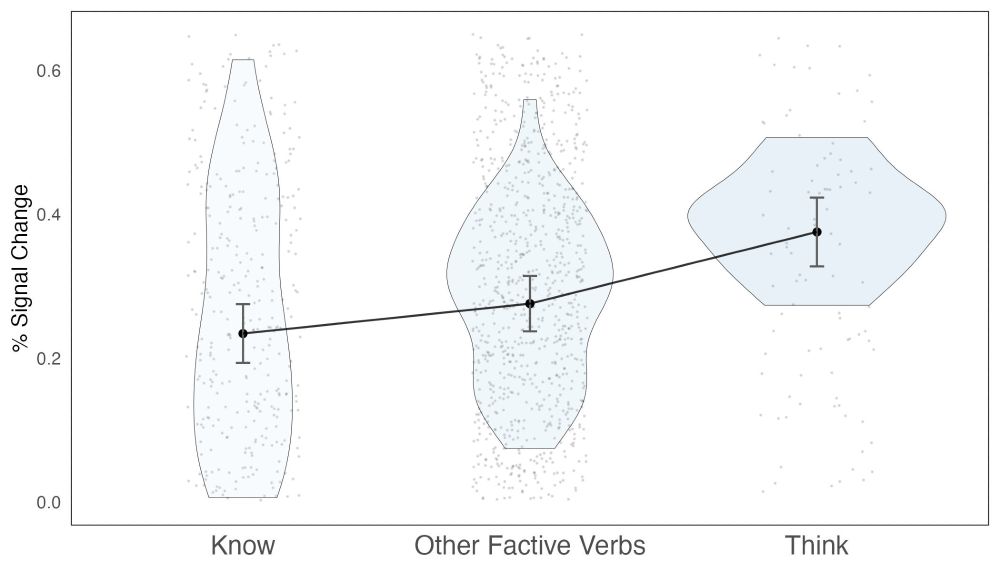
Percent signal change in RTPJ for each mental state verb: 'know' (left points and violin), other factive verbs, e.g., 'saw' or 'realized' (middle points and violin) and 'think' (right points and violin). Small points indicate trial-level responses, violins illustrate scenario- or item-level distributions, large dark points depict overall means, and error bars depict +/- 1 SEM.
And finally, we used a quite different methodology to show that people's neural patterns reveal a similar relationship: they have a lower BOLD response in the theory of mind network when evaluating knowledge than when evaluating belief (showing they didn't compute belief in computing knowledge):
26.03.2025 15:43 — 👍 1 🔁 0 💬 1 📌 0
UF Assistant Professor. Attention, Perception, Consciousness.
Associate Professor of Philosophy and Director of Cognitive Science at UC Davis. Philosophical Shark Jumper ®️ 🦈
Currently a postie. Planning the PhD.
Experimental anthropologist, cognitive scientist, dad, author of Ritual: How seemingly senseless acts make life worth living
Math models to understand societies and social psychology.
https://jliep.github.io/
PhD student at Computational Cognitive Neuroscience Lab, @dartmouthpbs.bsky.social
temporary associate professor at uio, norway & lead of the pilot reporting practices in psychology task force
research: http://tinyurl.com/jkjza86p
pilot study reporting task force: https://pilotreportingtf.github.io/
cognitive science, belief formation and change
master @Arizona State | alum @Edinburgh
PhD student in philosophy at the University of Staffordshire. Heidegger, analytic ethics (trust and mistrust), philosophy of tech/AI. Marylander. MA Staffs, MBA Duke. Wittgenstein and Cantor handshake numbers = 3 (via John Conway).
Postdoc @ Princeton AI Lab
Natural and Artificial Minds
Prev: PhD @ Brown, MIT FutureTech
Website: https://annatsv.github.io/
Associate Prof of Psychology. I study how you remember (episodic memory), but am also interested in other areas of science (astronomy, geology, astrophysics, paleobiology, ecology, meteorology, etc) and other things too (architecture, birds, transit, etc).
The Centre for Logic and Philosophy of Science (CLPS) at the Institute of Philosophy (@kuleuvenuniversity.bsky.social) focuses on #logic and #philsci, with a concentration on the philosophies of the special sciences • https://hiw.kuleuven.be/clps #philsky
The Center for Philosophy of Science at the University of Pittsburgh. Here to provide you with up-to-date information on Center news, events, and all the rest!
Postdoc UniOxford with MKFlugge, past PhD
DondersInst, into decision-making, learning, ultrasound stimulation, improving psychology & neuroscience. he/him
PhD Candidate - Neuropragmatics and Emotion Lab @mcgill.ca. I study why we enjoy and engage in social interactions.
website: elidom.github.io/home/
Post-doctoral research fellow in cognitive neuroscience (Oxford), interested in complex systems and in simple systems who believe they are complex systems
Professor of Biomedical Engineering and Neuroscience. Neural basis of cognition, cognitive development, deep brain stimulation.
https://lab.vanderbilt.edu/constantinidis-lab/home/
Vision scientist | PhD candidate @Dartmouth PBS | https://lab.faceblind.org/
Cognitive science journal published by MIT Press.
https://direct.mit.edu/opmi











